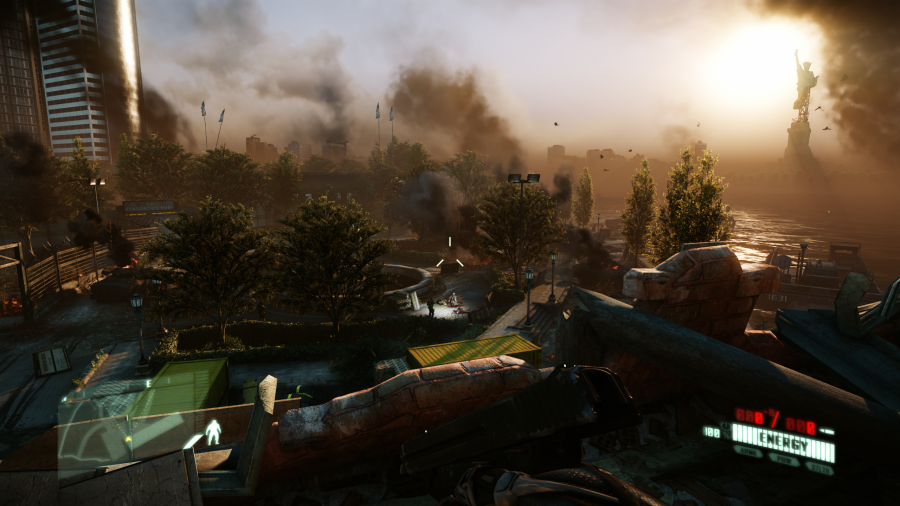Today’s release of the Crysis Remastered Trilogy, which includes newly revamped versions of Crysis 2 and Crysis 3 alongside last year’s Crysis Remastered, begs an age-old question that has become a deep-rooted part of PC gaming culture since the days of the 2007 original: but can it run Crysis? After spending some time with the remasters, we have thoughts and answers.
Before we discuss the Crysis Remastered Trilogy, it’s worth reflecting on why the Crysis series still means so much to so many, almost 14 years after the first game’s release. When it first debuted, Crysis pushed real-time visual fidelity to new heights and offered a level of interactivity that wasn’t commonplace in FPS games at the time, nor since. Understandably, this came at a massive cost to performance. Even now, the game provides a sizable challenge to today’s best graphics cards and best gaming CPUs, struggling to maintain a consistent 60fps at 4K max settings.
It remains a graphical and technological marvel with few games since leaving such a defining mark on PC gaming, which left its sequels – and currently leaves these remasters – with some understandably large nanosuit-styled shoes to fill.
Thankfully, developers Crytek and Saber Interactive have seemingly created a solid set of remasters that appear to live up to the Crysis name. They arrive with a host of graphical and performance improvements, as well as numerous bug fixes that continue to plague the original games, with each title benefitting from this new coat of polish to varying degrees.
The addition of voxel-based global illumination (SVOGI), which, alongside a new, more natural colour grading, is the feature that most appreciably transforms the look of Crysis and Crysis 2. Similar to other ray traced global illumination seen in games like Metro: Exodus, SVOGI simulates how light bounces in an environment following an initial contact point. This allows light to be affected by the colour of the surface it bounces from and adds more depth to a scene, creating more realistic shades and colours of light and shadow than would be possible through techniques like screen space ambient occlusion (SSAO).

Crysis 2 benefits the most from this change, in our opinion, particularly with the new colour grading. Gone is the poorly aged ‘modern’ overly blue hue that was popular at the time of its release and now the art design of its war-torn cityscape truly shines. However, the effect is not lost in the jungles and greneery of Crysis, with SVOGI greatly enhancing their respective game worlds with enhanced lights and shadows.
These remasters also bring ray traced reflections into the Crysis series for the first time. While their impact is more subtle than SVOGI’s, they replace and greatly improve surface reflections on glass surfaces and bodies of water further increasing the world’s fidelity. We can’t get over how cool it is to catch your super solider self reflected in a pane of glass. Furthermore, for those that must have maximum ray tracing, Crysis Remastered was updated earlier this year with a new experimental ‘RayTracing Boost’ toggle which enables ray traced reflections on more surfaces, as well as support for reflections on rough surfaces.
Naturally, pretty as these features make all three games, they don’t come for free. This is where Nvidia DLSS can help boost fps and make you feel less guilty for trying to run any of these games at maximum settings at less than optimal levels of performance. It’s also a means to improve image quality, being superior to all other forms of anti-aliasing available across all three titles. Unfortunately, AMD FSR isn’t included in these releases, so anyone with an AMD Radeon or older Nvidia GTX GPU in their gaming PC are out of luck for now but that’s not to rule out future support.

Fortunately, other improvements have been made to texture quality and depth of field in all three Crysis (Cryses?) games. This is in addition to optimisations that enable all three games, Crysis Remastered in particular, to make greater use of multiple threads and a laundry list of bug fixes which should help even lower-end hardware reap the benefits. For the bugs that do remain, the developers have provided regular patches following last year’s rocky launch of Crysis Remastered and we hope that trend will continue. One feature we’d like to see added via a future update is the ability to manually save your game, as checkpoints can be unreliable at the worst of times and somewhat date the new versions.
Speaking of bug fixes, the original releases had plenty left to fix. When revisiting the original Crysis and Crysis 2, we encountered numerous issues getting the games to run properly on Windows 10. The mild inconvenience of not detecting our native 1440p resolution and 144Hz refresh rate was quickly upstaged by respective locks to 24 and 65fps. Then, perhaps most disappointingly, installing Crysis 2 led to a false positive virus detection on Windows Defender. There are fixes for these issues, as helpfully detailed on PCGamingWiki, but it’s hard to recommend the older versions when the remasters run with little issue.
It’s clear that a lot of care and attention has gone into the Crysis Remastered Trilogy, with Crytek and Saber Interactive explicitly showing their love for the legacy of Crysis with the overkill ‘Can it run Crysis?’ settings preset in Crysis Remastered, keeping the meme alive a while longer. As a side note, Crysis 2 will probably be the greatest beneficiary of this new coat of paint, as its re-release is unhampered by a legacy renderer and visual downgrades that are later rectified post-launch.

 Crysis Remastered Trilogy Crysis Remastered Trilogy $49.99 View Network N earns affiliate commission from qualifying sales.
Crysis Remastered Trilogy Crysis Remastered Trilogy $49.99 View Network N earns affiliate commission from qualifying sales.
Priced at $49.99 USD / £44.99 GBP / €49.99, the Crysis Remastered Trilogy seems like a no-brainer if you’re looking for the best way, from both a visual and performance standpoint, to experience the iconic series. Plus, if your gaming PC isn’t quite giving you the fidelity or frame rate you want, or that you feel Crysis deserves, then you’ll be pleased to know you can play all three games on Nvidia’s Geforce Now game streaming service.
So, in answer to a question posed earlier in this piece, ‘but can it run Crysis?’ Yes. Whether it is an aging PC or a device supported by Geforce Now, it can (probably) run Crysis.
